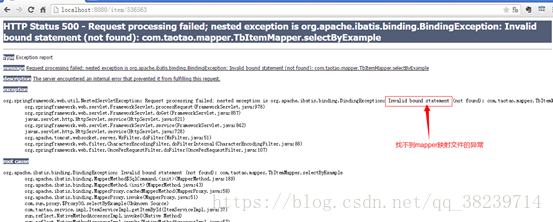1 SSM框架整合
1.1.1 Dao层
使用mybatis框架。创建SqlMapConfig.xml。
创建一个applicationContext-dao.xml
1、配置数据源
2、需要让spring容器管理SqlsessionFactory,单例存在。
3、把mapper的代理对象放到spring容器中。使用扫描包的方式加载mapper的代理对象。
1.1.2 Service层
1、事务管理
2、需要把service实现类对象放到spring容器中管理。
1.1.3 表现层
1、配置注解驱动
2、配置视图解析器
3、需要扫描controller
1.1.4 Web.xml
1、spring容器的配置
2、Springmvc前端控制器的配置
3、Post乱码过滤器
2 SSM框架案例模板
2.1 Dao层(mybatis)
1.使用mybatis框架,需要有maybatis核心配置文件,sqlMapConfig.xml,其他mapper.xml(配置sql语句)和mapper.java(java接口)都在mapper包下,使用spring容器扫描mapper包导入,并且管理mapper。在spring配置文件中配置。
sqlMapConfig.xml
<?xml version="1.0" encoding="UTF-8" ?>
<!DOCTYPE configuration
PUBLIC "-//mybatis.org//DTD Config 3.0//EN"
"http://mybatis.org/dtd/mybatis-3-config.dtd">
<configuration>
/*为pojo(model)起别名,之后调用直接使用别名*/
<typeAliases>
<package name="model"/>
</typeAliases>
</configuration>
2. mybatis操作Dao层需要数据库和会话,会话由会话工厂生成,使用spring配置文件来配置数据源,使用spring配置文件来配置sqlSessionFactory,让spring来管理sqlSessionFactory,spring管理mapper,使用扫描包的方式加载mapper代理对象,创建配置文件applicationContext-dao.xml配置数据源和sqlSessionFactory和mapper扫描
spring-dao.xml
<?xml version="1.0" encoding="UTF-8"?>
<beans xmlns="http://www.springframework.org/schema/beans"
xmlns:context="http://www.springframework.org/schema/context" xmlns:p="http://www.springframework.org/schema/p"
xmlns:aop="http://www.springframework.org/schema/aop" xmlns:tx="http://www.springframework.org/schema/tx"
xmlns:xsi="http://www.w3.org/2001/XMLSchema-instance"
xsi:schemaLocation="http://www.springframework.org/schema/beans http://www.springframework.org/schema/beans/spring-beans-4.0.xsd
http://www.springframework.org/schema/context http://www.springframework.org/schema/context/spring-context-4.0.xsd
http://www.springframework.org/schema/aop http://www.springframework.org/schema/aop/spring-aop-4.0.xsd http://www.springframework.org/schema/tx http://www.springframework.org/schema/tx/spring-tx-4.0.xsd
http://www.springframework.org/schema/util http://www.springframework.org/schema/util/spring-util-4.0.xsd">
<!--加载数据源属性-->
<context:property-placeholder location="classpath*:db.properties"/>
<!--配置数据源-->
<bean id="dataBase" class="com.alibaba.druid.pool.DruidDataSource">
<property name="url" value="${jdbc.url}"/>
<property name="name" value="${jdbc.username}"/>
<property name="password" value="${jdbc.password}" />
<property name="driverClassName" value="${jdbc.driver}" />
<property name="maxActive" value="10" />
<property name="minIdle" value="5" />
</bean>
<!-- 配置sqlsessionFactory -->
<bean id="sqlSessionFactory" class="org.mybatis.spring.SqlSessionFactoryBean">
<property name="dataSource" ref="dataBase"/>
<property name="configLocation" value="classpath:mybatis/SqlMapConfig.xml"/>
</bean>
<!-- 配置扫描包,加载mapper代理对象 -->
<bean class="org.mybatis.spring.mapper.MapperScannerConfigurer">
<property name="basePackage" value="dao.mapper"></property>
</bean>
</beans>
db.properties
jdbc.driver=com.mysql.jdbc.Driver
jdbc.url=jdbc:mysql://127.0.0.1:3306/ssmtaotao
jdbc.username=root
jdbc.password=123456
log4j.properties
# Global logging configuration
#\u5728\u5f00\u53d1\u73af\u5883\u4e0b\u65e5\u5fd7\u7ea7\u522b\u8981\u8bbe\u7f6e\u6210DEBUG\uff0c\u751f\u4ea7\u73af\u5883\u8bbe\u7f6e\u6210info\u6216error
#在开发环境日志级别要设置为DEBUG,在生产环境设置成info或error
log4j.rootLogger=DEBUG, stdout
# Console output...
log4j.appender.stdout=org.apache.log4j.ConsoleAppender
log4j.appender.stdout.layout=org.apache.log4j.PatternLayout
log4j.appender.stdout.layout.ConversionPattern=%5p [%t] - %m%n
2.2 Service层(Spring)
1. spring在service层实现,spring的功能有IOC(控制反转:将对象创建交给spring实现)、DI(依赖注入:在对象创建时将属性注入到对象)、AOP(面向切面编程)。控制反转(@Component/Controller/Service/Respository)、依赖注入(@Autowired/Resource)、面向切面编程(@Aspect)可以使用注解。因为使用了注解,所以需要注解扫描。
在applicationContext-service.xml中进行配置。
spring-service.xml
<?xml version="1.0" encoding="UTF-8"?>
<beans xmlns="http://www.springframework.org/schema/beans"
xmlns:context="http://www.springframework.org/schema/context" xmlns:p="http://www.springframework.org/schema/p"
xmlns:aop="http://www.springframework.org/schema/aop" xmlns:tx="http://www.springframework.org/schema/tx"
xmlns:xsi="http://www.w3.org/2001/XMLSchema-instance"
xsi:schemaLocation="http://www.springframework.org/schema/beans http://www.springframework.org/schema/beans/spring-beans-4.0.xsd
http://www.springframework.org/schema/context http://www.springframework.org/schema/context/spring-context-4.0.xsd
http://www.springframework.org/schema/aop http://www.springframework.org/schema/aop/spring-aop-4.0.xsd http://www.springframework.org/schema/tx http://www.springframework.org/schema/tx/spring-tx-4.0.xsd
http://www.springframework.org/schema/util http://www.springframework.org/schema/util/spring-util-4.0.xsd">
<!--开启注解扫描,扫描service实现类-->
<context:component-scan base-package="service"/>
</beans>
2. seivice层要进行事务管理,在spring中进行配置来管理事务。先配置事务管理器来管理事务,再使用事务管理器来配置建议事务,再写一个切面来使用建议事务。
spring-transaction.xml
<?xml version="1.0" encoding="UTF-8"?>
<beans xmlns="http://www.springframework.org/schema/beans"
xmlns:context="http://www.springframework.org/schema/context" xmlns:p="http://www.springframework.org/schema/p"
xmlns:aop="http://www.springframework.org/schema/aop" xmlns:tx="http://www.springframework.org/schema/tx"
xmlns:xsi="http://www.w3.org/2001/XMLSchema-instance"
xsi:schemaLocation="http://www.springframework.org/schema/beans http://www.springframework.org/schema/beans/spring-beans-4.0.xsd
http://www.springframework.org/schema/context http://www.springframework.org/schema/context/spring-context-4.0.xsd
http://www.springframework.org/schema/aop http://www.springframework.org/schema/aop/spring-aop-4.0.xsd http://www.springframework.org/schema/tx http://www.springframework.org/schema/tx/spring-tx-4.0.xsd
http://www.springframework.org/schema/util http://www.springframework.org/schema/util/spring-util-4.0.xsd">
<!-- 事务管理器 -->
<bean id="transactionManager"
class="org.springframework.jdbc.datasource.DataSourceTransactionManager">
<!-- 数据源 -->
<property name="dataSource" ref="dataBase"/>
</bean>
<!-- 通知 -->
<!--事务建议-->
<tx:advice id="txAdvice" transaction-manager="transactionManager">
<!--事务建议属性-->
<tx:attributes>
<!-- 传播行为 -->
<tx:method name="save*" propagation="REQUIRED" />
<tx:method name="insert*" propagation="REQUIRED" />
<tx:method name="add*" propagation="REQUIRED" />
<tx:method name="create*" propagation="REQUIRED" />
<tx:method name="delete*" propagation="REQUIRED" />
<tx:method name="update*" propagation="REQUIRED" />
<tx:method name="find*" propagation="SUPPORTS" read-only="true" />
<tx:method name="select*" propagation="SUPPORTS" read-only="true" />
<tx:method name="get*" propagation="SUPPORTS" read-only="true" />
</tx:attributes>
</tx:advice>
<!-- 声明切面 -->
<aop:config>
<!--使用一个通知器:<aop:advisor/>把这个切面和tx:advice绑定在一起,表示当这个切面:执行时tx:advice定义的通知逻辑将被执行-->
<aop:advisor advice-ref="txAdvice"
pointcut="execution(* service.*.*(..))" />
</aop:config>
</beans>
2.3 表现层(web层:SpringMVC)
1. SpringMVC有四大组件,分别是前端控制器(地址接收回来之后指挥其他组件工作)、处理器映射器、处理器适配器、视图解析器。
处理器映射器和处理器适配器可以使用注解驱动<mvc:annotation-driven>加载,处理器映射器使用是使用注解(@RequestMapping)。注解扫描处理器映射器实现IOC。
视图解析器是在springMVC.xml中配置。
前端控制器是在web.xml中配置。
springMVC.xml中的配置
<?xml version="1.0" encoding="UTF-8"?>
<beans xmlns="http://www.springframework.org/schema/beans"
xmlns:xsi="http://www.w3.org/2001/XMLSchema-instance" xmlns:p="http://www.springframework.org/schema/p"
xmlns:context="http://www.springframework.org/schema/context"
xmlns:mvc="http://www.springframework.org/schema/mvc"
xsi:schemaLocation="http://www.springframework.org/schema/beans http://www.springframework.org/schema/beans/spring-beans.xsd
http://www.springframework.org/schema/mvc http://www.springframework.org/schema/mvc/spring-mvc-4.0.xsd
http://www.springframework.org/schema/context http://www.springframework.org/schema/context/spring-context.xsd">
<!--注解扫描,实现IOC-->
<context:component-scan base-package="controller"/>
<!--注解驱动-->
<mvc:annotation-driven/>
<!--视图解析器-->
<bean class="org.springframework.web.servlet.view.InternalResourceViewResolver">
<property name="prefix" value="/WEB-INF/jsp/" />
<property name="suffix" value=".jsp" />
</bean>
</beans>
2.4 web.xml的配置
1. spring容器配置
2. springMVC前端控制器的配置
3. post乱码过滤器的配置
web.xml
<!DOCTYPE web-app PUBLIC
"-//Sun Microsystems, Inc.//DTD Web Application 2.3//EN"
"http://java.sun.com/dtd/web-app_2_3.dtd" >
<web-app xmlns:xsi="http://www.w3.org/2001/XMLSchema-instance"
xmlns="http://xmlns.jcp.org/xml/ns/javaee"
xsi:schemaLocation="http://xmlns.jcp.org/xml/ns/javaee
http://xmlns.jcp.org/xml/ns/javaee/web-app_3_1.xsd"
id="WebApp_ID" version="3.1" metadata-complete="false">
<display-name>Archetype Created Web Application</display-name>
<welcome-file-list>
<welcome-file>index.html</welcome-file>
<welcome-file>index.htm</welcome-file>
<welcome-file>index.jsp</welcome-file>
<welcome-file>default.html</welcome-file>
<welcome-file>default.htm</welcome-file>
<welcome-file>default.jsp</welcome-file>
</welcome-file-list>
<!-- 加载spring容器 -->
<context-param>
<param-name>contextConfigLocation</param-name>
<param-value>classpath*:spring/spring-*.xml</param-value>
</context-param>
<listener>
<listener-class>org.springframework.web.context.ContextLoaderListener</listener-class>
</listener>
<!-- 解决post乱码 -->
<filter>
<filter-name>CharacterEncodingFilter</filter-name>
<filter-class>org.springframework.web.filter.CharacterEncodingFilter</filter-class>
<init-param>
<param-name>encoding</param-name>
<param-value>utf-8</param-value>
</init-param>
</filter>
<filter-mapping>
<filter-name>CharacterEncodingFilter</filter-name>
<url-pattern>/*</url-pattern>
</filter-mapping>
<!-- springmvc的前端控制器 -->
<!-- <servlet>
<servlet-name>taotao-manager</servlet-name>
<servlet-class>org.springframework.web.servlet.DispatcherServlet</servlet-class>
<!– contextConfigLocation不是必须的, 如果不配置contextConfigLocation, springmvc的配置文件默认在:WEB-INF/servlet的name+"-servlet.xml" –>
<init-param>
<param-name>contextConfigLocation</param-name>
<param-value>classpath:springMVC/springMVC.xml</param-value>
</init-param>
<load-on-startup>1</load-on-startup>
</servlet>
<servlet-mapping>
<servlet-name>taotao-manager</servlet-name>
<url-pattern>*.do</url-pattern>
</servlet-mapping>-->
<servlet>
<servlet-name>springServlet</servlet-name>
<servlet-class>org.springframework.web.servlet.DispatcherServlet</servlet-class>
<init-param>
<param-name>contextConfigLocation</param-name>
<param-value>classpath*:springMVC/springMVC.xml</param-value>
</init-param>
<load-on-startup>1</load-on-startup>
</servlet>
<servlet-mapping>
<servlet-name>springServlet</servlet-name>
<url-pattern>/</url-pattern>
</servlet-mapping>
</web-app>

解决方法:
在pom文件中添加如下内容:
<!-- 如果不添加此节点mybatis的mapper.xml文件都会被漏掉。 -->
<build>
<resources>
<resource>
<directory>src/main/java</directory>
<includes>
<include>**/*.properties</include>
<include>**/*.xml</include>
</includes>
<filtering>false</filtering>
</resource>
</resources>
</build>
例子中使用这个
<resources>
<resource>
<directory>src/main/java</directory>
<includes>
<include>dao/mapper/**/*.xml</include>
</includes>
<filtering>false</filtering>
</resource>
</resources>
2.5 model,pojo类
TbItem.java
package model;
import java.util.Date;
public class TbItem {
private Longid;
private Stringtitle;
private StringsellPoint;
private Longprice;
private Integernum;
private Stringbarcode;
private Stringimage;
private Longcid;
private Bytestatus;
private Datecreated;
private Dateupdated;
public LonggetId() {
return id;
}
public void setId(Longid) {
this.id = id;
}
public StringgetTitle() {
return title;
}
public void setTitle(Stringtitle) {
this.title = title == null? null :title.trim();
}
public StringgetSellPoint() {
return sellPoint;
}
public void setSellPoint(StringsellPoint) {
this.sellPoint = sellPoint == null ? null : sellPoint.trim();
}
public LonggetPrice() {
return price;
}
public void setPrice(Longprice) {
this.price = price;
}
public IntegergetNum() {
return num;
}
public void setNum(Integernum) {
this.num = num;
}
public StringgetBarcode() {
return barcode;
}
public void setBarcode(Stringbarcode) {
this.barcode = barcode == null? null :barcode.trim();
}
public StringgetImage() {
return image;
}
public void setImage(Stringimage) {
this.image = image == null? null : image.trim();
}
public LonggetCid() {
return cid;
}
public void setCid(Longcid) {
this.cid = cid;
}
public BytegetStatus() {
return status;
}
public void setStatus(Bytestatus) {
this.status = status;
}
public DategetCreated() {
return created;
}
public void setCreated(Datecreated) {
this.created = created;
}
public DategetUpdated() {
return updated;
}
public void setUpdated(Dateupdated) {
this.updated = updated;
}
}
2.6 mapper(dao层)
ItemsMapper.java
package dao.mapper;
import model.TbItem;
import java.util.List;
public interface ItemsMapper {
TbItem findItemById(Long itemId) throws Exception;
List<TbItem> findItems() throws Exception;
}
ItemsMapper.xml
<?xml version="1.0" encoding="UTF-8" ?>
<!DOCTYPEmapper
PUBLIC"-//mybatis.org//DTD Mapper 3.0//EN"
"http://mybatis.org/dtd/mybatis-3-mapper.dtd">
/*namespace很重要,是ItemsMapper.xml对应的ItemsMapper.java的地址 */
<mapper namespace="dao.mapper.ItemsMapper">
<!-- 根据id查询商品信息 -->
<select id="findItemById" parameterType="Long" resultType="tbItem">
select * from tb_item
<where>
id=#{id}
</where>
</select>
<!-- 查询商品信息 -->
<select id="findItems" resultType="tbItem">
select * from tb_item
</select>
</mapper>2.7 service层
ItemsService.java
package service.items;
import java.util.List;
import model.TbItem;
public interface ItemsService {
TbItem findItemById(Long itemId)throws Exception;
List<TbItem> findItems()throws Exception;
}
ItemsServiceImpl.java
package service.items;
import java.util.List;
import dao.mapper.ItemsMapper;
import model.TbItem;
import org.springframework.beans.factory.annotation.Autowired;
import org.springframework.stereotype.Service;
@Service
public class ItemsServiceImpl implements ItemsService {
@Autowired
private ItemsMapper itemsMapper;
public TbItem findItemById(Long itemId) throws Exception {
TbItem tbItem=itemsMapper.findItemById(itemId);
return tbItem;
}
public List<TbItem> findItems() throws Exception {
List<TbItem> tbItemList= (List<TbItem>) itemsMapper.findItems();
return tbItemList;
}
}
2.8 controller层
ItemsController.java
package controller.items;
import model.TbItem;
import org.springframework.beans.factory.annotation.Autowired;
import org.springframework.stereotype.Controller;
import org.springframework.web.bind.annotation.*;
import service.items.ItemsService;
import java.util.List;
/*@RequestMapping("/items")*/
@Controller
public class ItemsController {
@Autowired
private ItemsService itemsService;
@RequestMapping("/findItemById.do")
public TbItem findItemById(@PathVariable Long itemId) throws Exception {
TbItem tbItem=itemsService.findItemById(itemId);
return tbItem;
}
@RequestMapping(value = "/findItems.do",method = RequestMethod.GET)
public List<TbItem> findItems() throws Exception {
List<TbItem> tbItem=itemsService.findItems();
System.out.println(tbItem);
return tbItem;
}
}测试:http://localhost:8080/findItems.do








 本文详细介绍SSM(Spring、SpringMVC、MyBatis)框架整合的过程及案例实践,包括各层配置详解,如DAO层使用MyBatis进行数据访问,Service层实现业务逻辑并进行事务管理,以及Controller层如何响应前端请求。
本文详细介绍SSM(Spring、SpringMVC、MyBatis)框架整合的过程及案例实践,包括各层配置详解,如DAO层使用MyBatis进行数据访问,Service层实现业务逻辑并进行事务管理,以及Controller层如何响应前端请求。
















 1620
1620

 被折叠的 条评论
为什么被折叠?
被折叠的 条评论
为什么被折叠?








